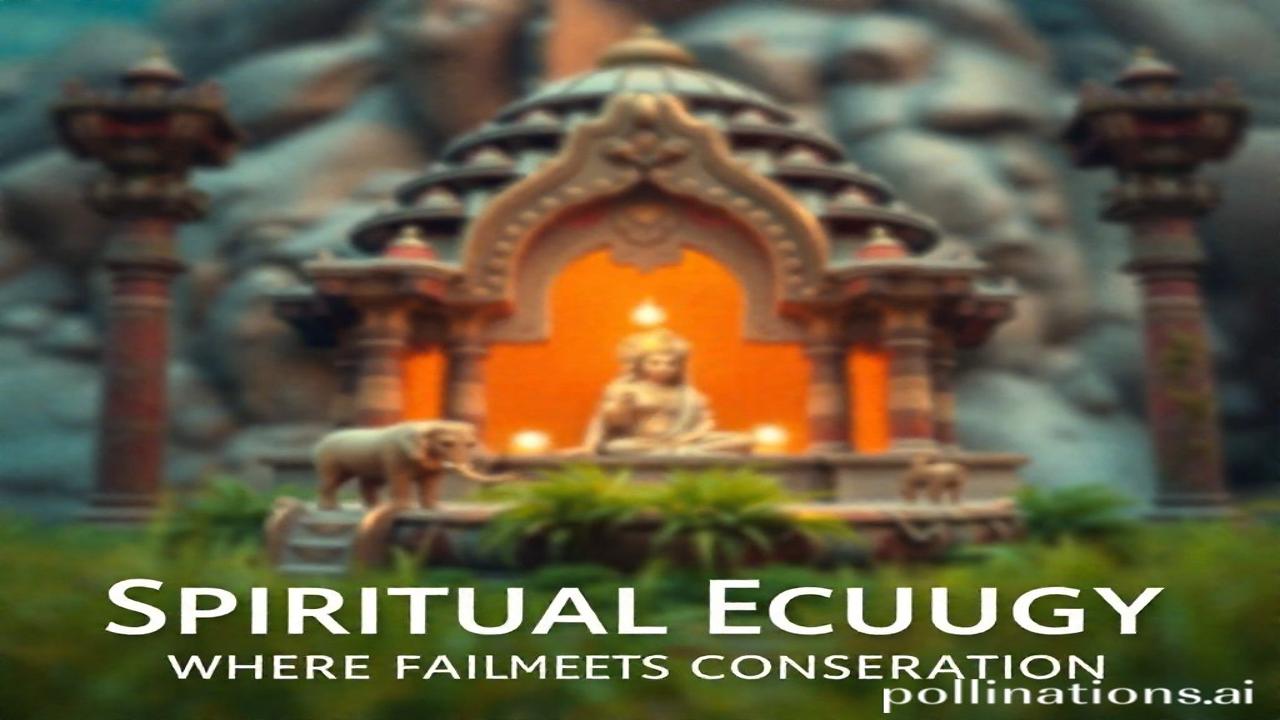Spiritual Ecology: Jab Aastha Milati Hai Prakriti Se
“Kabhi socha hai, jab Ganga kinare sham dhalti hai, to uss hawa mein kya hota hai? Sirf paani ki nami nahi, ek gehra ehsaas bhi hota hai. Jaise, humari dharti maata humse kuch keh rahi hai…”
Imagine standing on the banks of the Ganga, the air thick with the scent of incense and the gentle sounds of temple bells. This feeling, this connection to nature, isn’t just a fleeting emotion. It’s deeply woven into the fabric of Indian culture and spirituality. It’s the heart of Spiritual Ecology – where faith and conservation intertwine.
Kya Hai Spiritual Ecology?
Spiritual ecology is the understanding that environmental problems are not just technological or economic issues, but also deeply rooted in our values, beliefs, and spiritual relationship with the natural world. Yeh ek aisa drishtikon hai jo kehta hai ki prakriti sirf resources nahin hai, balki ek pavitra sthal hai jiska sanrakshan humara dharmik aur naitik kartavya hai. It recognizes that true environmental sustainability requires a fundamental shift in our consciousness and a reconnection with the sacredness of nature.
Aisa Kab Aur Kahan Hua? The Roots in Ancient India
While the term “Spiritual Ecology” is relatively new, the concept itself is ancient, especially in India. Think about the Vedic period, dating back to around 1500 BCE. The Vedas, our oldest scriptures, are filled with hymns praising various natural elements – Agni (fire), Prithvi (earth), Vayu (air), Varuna (water), and Surya (sun). These weren’t just deities to be worshipped; they were recognized as essential components of a balanced and thriving ecosystem.
In ancient India, forests were often considered sacred groves, protected by local communities. These groves, known as devrais or orans, were believed to be inhabited by deities and spirits. Cutting down trees or hunting animals within these groves was strictly prohibited. These practices were a form of practical conservation rooted in spiritual beliefs.
Importance in Our History and Culture: A Legacy of Reverence
Spiritual ecology is important because it offers a powerful framework for addressing the environmental challenges we face today. Our ancestors understood this intuitively. The deep respect for nature was ingrained in their daily lives. It wasn’t just about following rules; it was about living in harmony with the environment.
The teachings of figures like the Buddha, who emphasized compassion for all living beings, further solidified this eco-centric worldview. Jainism, with its principle of ahimsa (non-violence), also played a significant role in promoting environmental consciousness. The Ashoka Chakra on our national flag is a testament to this philosophy.
Zameeni Sach: Log Aur Jeevan – The Rhythm of Life
Imagine a small village nestled at the foothills of the Himalayas. Here, people live a simple life, closely connected to the land.
“Ma Rukmini, aaj subah jaldi uth kar nadi gayi,” says a young boy named Rohan. “Unko puja ke liye Gangajal chahiye tha.”
Rukmini, like other women in the village, understands the sacredness of the river. They draw water respectfully, knowing that the river is not just a source of life, but also a vital part of their spiritual well-being. They pray to Ganga Maiya to protect their village and bless their crops.
The villagers cultivate their fields using traditional methods, avoiding harmful chemicals. They understand that healthy soil is essential for a healthy harvest. They share their resources and celebrate the bounty of nature with festivals and rituals. Their lives are a testament to the power of spiritual ecology.
Dharohar Aur Pehchaan: Echoes in Modern India
Even today, we see the echoes of spiritual ecology in various aspects of Indian life.
- Rituals and Festivals: Many Hindu festivals, like Holi and Diwali, are deeply connected to nature. Holi celebrates the arrival of spring and the renewal of life, while Diwali is associated with the harvest season and the worship of Lakshmi, the goddess of wealth and prosperity.
- Art and Architecture: Traditional Indian art and architecture often feature elements of nature, such as trees, animals, and flowers. The intricate carvings on temples and the vibrant colors used in paintings reflect a deep appreciation for the beauty and diversity of the natural world.
- Language and Values: Our languages are replete with proverbs and idioms that emphasize the importance of respecting nature. The concept of Vasudhaiva Kutumbakam (the world is one family) promotes a sense of interconnectedness and responsibility towards the environment.
This spiritual connection to nature is a crucial part of Bharatiyata (Indianness) and our modern identity. It reminds us that we are not separate from nature, but an integral part of it.
Mazedar Tathya Ya Bhram-Bhanjak: Shocking Truths
Myth: Protecting nature is a Western concept.
Reality: India has a long and rich history of environmental conservation rooted in spiritual beliefs and practices. The Chipko movement, where women hugged trees to prevent deforestation, is a powerful example of this indigenous environmentalism.
Drishya Aur Bhavnaayein: A Sensory Symphony
Close your eyes and imagine the scene:
The air smells of sandalwood incense and freshly baked bread. The temple bells chime in the distance, creating a soothing melody. The cool breeze rustles through the leaves of the ancient banyan tree, its roots reaching deep into the earth. The temple walls feel cool and smooth against your hand. The sun sets in a blaze of orange and pink, casting a warm glow on the landscape.
This is the feeling of being connected to nature, of experiencing the sacredness of the earth.
Antim Vichar Ya Uddharan: A Closing Reflection
We must remember that the solutions to our environmental problems lie not just in technology and policy, but also in our hearts and minds. We need to rediscover our spiritual connection to nature and embrace a more sustainable way of life.
“प्रकृति रक्षति रक्षिता” (Prakriti Rakshati Rakshita): Nature protects those who protect it. This ancient Sanskrit saying reminds us that our fate is intertwined with the fate of the natural world. Let us protect nature, so that nature can protect us.
